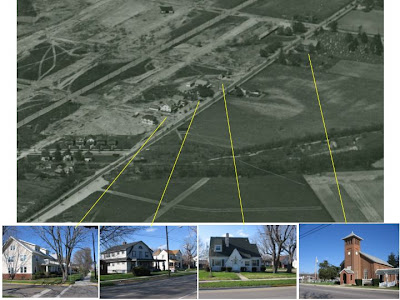The Frigidaire era began in 1926 or 1927 when GM decided to expand and reconstruct the old Dayton-Wright factory to make refrigerators as an expansion from the downtown plant. This probably kicked off the real estate boom investigated in a previous post.
We’ll take a closer look at this area… …which corresponds to this pix, probably from 1940 or 1941, just before WWII.
…which corresponds to this pix, probably from 1940 or 1941, just before WWII.
Some labels. The interurban was out of business by now as the tracks by the “CL&E shops” are gone. But during the 14 year overlap between Frigidaire and interurban service there was a freight service developed, with an industrial spur running out from the mainline to the plant. Subdivision activity also appears, particularly Moraine Center and the second section of Moraine, now under development as the economy was coming out of the Depression. It appears Kettering Boulevard is being built around this time; though it shows up in earlier maps this was apparently a paper highway to go along with the paper suburb.
A close-up of the new Frigidaire plant, showing how it was a major expansion and reconstruction of the old Dayton Wright factory, forcing the realignment of Springboro Pike.
One can also see what looks like the first parking lots under construction.
Since this was well outside the city one had to reverse commute. Apparently during the first years of operation there was no parking! The way people got to work here was either via interurban or via the Big Four (and maybe via jitney). During 1920s The Big Four ran two commuter trains per day, one outbound & one inbound, to Moraine. No station, no platform, the train apparently just pulled over on a siding and the workers just got off and on. Nothing fancy for the working stiff.
This interior shot of the plant shows an unusual feature…the indoor loading area for the interurban…apparently the industrial spur ran inside the building, as one can see one of the interurban box cars spotted on this track (note the rear door, which you never see in conventional box cars). CL&E had a very aggressive freight program and provided an early version of “next day” just-in-time service, by rail instead of via air the way UPS or FedEx does. But they operated this over a single track system, at night, without block signals, so garbled or misunderstood train orders risked high-speed head-on collisions.
CL&E had a very aggressive freight program and provided an early version of “next day” just-in-time service, by rail instead of via air the way UPS or FedEx does. But they operated this over a single track system, at night, without block signals, so garbled or misunderstood train orders risked high-speed head-on collisions.
Fortunately this particular area was double-tracked.
The interurban also provided at least hourly passenger service (maybe more frequent during rush hour). Commuter ("tripper") service was offered at times as far as Miamisburg, with apparently two stations at Moraine.
Going to work via interurban. This is the Springboro Pike station or flag stop. After the C&LE went under the Dayton & Suburban Railway provide service to Moraine until finally ending in 1941, one of the longer lasting interuban services in the US.
One can tell it was a bit of a walk from the station to the factory, so the Big Four was maybe a better alternative from a convenience standpoint since it let you off right at the plant gate. In Dayton the interurban ended at the what is now the Webster Station tavern…that was their station.
After that the only way to get out here was by car and maybe bus
Moraine Suburbia Early Take-Off
Coming out of the Depression one can see a small building boom going on in Moraine. 
Some of the Moraine Center houses might have predated the Depression, but there was a lot of new construction going on too, as can be seen by the building sites. These are some of the last of the old school housing, probably following designs from the 1920s or 1930s. This plat was finished out in postwar housing styles; cottages and early ranches.
Moraine City Section 2 was finally becoming more than a paper plat, with streets being laid out, and early houses along Dixie Drive, including a cottage style house, being the popular style from the later 1930s and 1940s. The old church was one of two,; one was torn down and this one survives as a local landmark (dating back to the 1880s).
A close up of the Slanker Plat, showing the old Cureton Foundry (by this time I think a compressed air place), the interurban, and the Springboro/Dixie intersection. It looks like a nice little collection of houses was springing up here.
The Slanker Plat today, demonstrating how the landscape has been transformed.
A birds-eye of the modern landscape. The inset shows the little ditch that parallel Dixie, with ditch gaurds where Springboro bridges it. Same location, 66 years or so apart
In modern times the landscape is brutalized, re-engineered to sprawl scale, with the ditch becoming much larger to accept runoff from postwar subdivisions and hard surfaces. The houses disappear, replaced by who knows what…the bigger ditch? Yet one can still see how the interurban ROW still determines lot lines and such, as sort of a ghostly presence driving what are to us inexplicable moves in the landscape.
Saturday, December 27, 2008
Moraine City in the early Frigidaire Era
Subscribe to:
Post Comments (Atom)

2 comments:
I have several pics that may be useful for you, and would like to use some as well, please contact me at avietor@moraineoh.org
Hi there have a Model 26 ironer I'm trying to sell. It seemed right to find someone in the area that it was made that could appreciate it's worth. Please let me know if interested.
My name is Chelsey.
Email- queen_anne_13@yahoo.com
Post a Comment